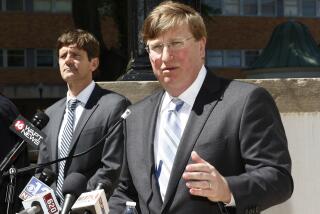Curiosity Nurtured in Black Youngsters
- Share via
BLOOMINGDALE, Mich. — Many of the youngsters who come to LeRoy Ray Jr.’s farm have never gazed at a star-filled night sky, tended a garden or cooked a hot dog on an open fire.
More important to Ray, most have never met a scientist who is black.
For 20 years this biochemist and director of Black Americana Studies at Western Michigan University has done what he says the U.S. public school system has failed to do: get black youngsters excited about science.
Ray hasn’t kept count, but he figures thousands of young people have passed through his farm in southwestern Michigan and its Hands-On Science Program.
The program takes about 60 children at a time, 250 in the course of a year, on an annual budget of $15,000 to $20,000.
The youngsters come after school and on Saturdays from nearby communities, or for a week at a time from as far as Chicago, 150 miles to the southwest, for a year-round offering that includes stints at the university laboratories.
Black children have been taught, however subtly, that they’re not smart enough to handle science and mathematics, said Ray, a 62-year-old native Texan. “Parents tell their kids they don’t like science or they’re no good with numbers--and that’s wrong.”
Ray’s love for science was ignited as a child when he visited the hospital where his father worked as head cook.
“Children don’t know they can’t do something until you tell them so,” said Ray, his eyes shaded by a black Stetson as he leaned against an old pickup. “You should see their eyes when they get here.”
On the farm, everywhere you turn--even the bathrooms--there’s reading material about and photographs of black scientists.
People like Dr. George Washington Carver, the botanist who promoted the cultivation of peanuts as a protein source and developed more than 300 peanut and soybean byproducts; Dr. Charles R. Drew, a hematologist who discovered the method of preserving blood plasma for emergencies during World War II; Dr. Daniel Hale Williams, who pioneered open-heart surgery and founded Chicago’s Provident Hospital.
For his year-round program, Ray brings in instructors and guest speakers--all unpaid--from the nearby Upjohn Co. pharmaceutical labs and farther afield. He sets an eight-minute limit on lectures, however; this is a hands-on program.
Student assignments are unsophisticated, and there are no computers. The students, mostly second- through sixth-graders, may be asked to collect water samples from his pond to test the pH levels or measure the feed for his chickens.
First- and second-graders learn to identify trees by matching fallen leaves.
Students put on plays and read poetry on the barn stage. They care for blueberry bushes and rows of sweet corn, fry up blue gills they catch in Ray’s pond and sleep in a book-lined bunkhouse.
Among the program’s graduates are computer engineers, dentists and doctors.
They include Courtney Boyd, 15, who has been to Ray’s farm every year since first grade. She plans to be a pediatrician.
“Dr. Ray’s farm opened my knowledge for science,” the Kalamazoo 10th-grader said. Her three brothers are all past or present program participants as well. The oldest is in college learning computer engineering. Her 11-year-old brother wants to become a paleontologist.
It’s hard to know if Ray’s farm is the reason so many of his students pursue careers in science and math. Most were referred to him after showing interest in those subjects.
Educators familiar with the program say it works because Ray takes a seed of interest and adds the nurturing confidence needed for that seed to take root.
“You just see the excitement in these children and it carries over into the rest of their school life,” said Linda Comer, principal of Lincoln Magnet Elementary School in Kalamazoo.
Education experts say such programs are a boon for youngsters who may perform poorly in lecture-based science classes only because they need to practice science for themselves to blossom.
“When they’re doing experiments, manipulating objects, there’s sometimes a very, very significant jump in performance,” said Peter C. Scales of the Center for Early Adolescence at the University of North Carolina at Chapel Hill. “Some of them become quite high achievers.”
Ray says many youngsters are intimidated by science, and it’s no wonder. “Science is not cotton balls and construction paper,” he said. “It’s working in a lab, doing experiments again and again.”
He founded the program to give children that experience and because he was frustrated about the paucity of black science majors and science faculty at Western Michigan University when he was hired in 1973.
The university, skeptical at first, now provides most of the financial support. Ray supplements this with private donations and some of his own money.
The children attend free.
More than 90% of Ray’s students are black, in part because few youngsters of other races apply.
The students work hard and there are no luxuries here: no TV, no basketball hoop, no volleyball.
“When they’re here, they do science all day,” Ray said. “I’m here to make scientists of them. They can do those other things at home.”
More to Read
Sign up for Essential California
The most important California stories and recommendations in your inbox every morning.
You may occasionally receive promotional content from the Los Angeles Times.













